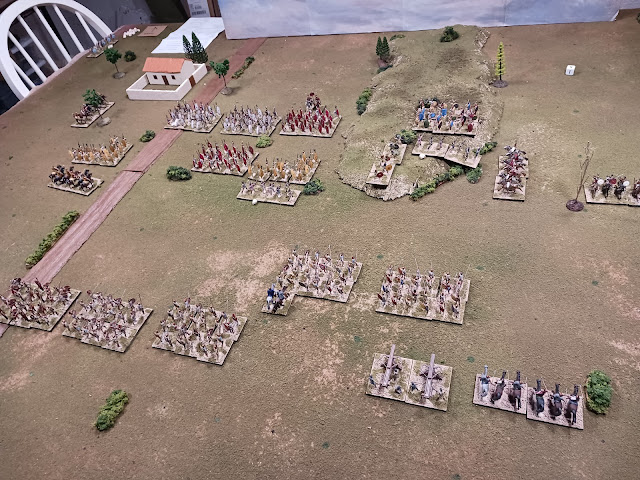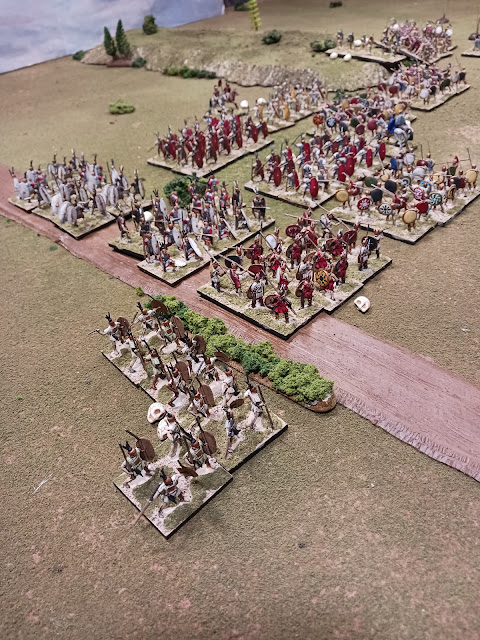Three Ages of Rome, a new ancients ruleset published earlier this year, seemed very promising based on its own description. The book is affordable so I took a chance and ordered a copy. On first read through it felt like it might be a lighter, faster descendant of Hail Caesar, but perhaps with not so much dice rolling and a simpler command system. As units lose melees or take hits in shooting they simply fall from an okay status to disordered, then disordered-to-disrupted, then disrupted-to-routed. Use six-sided dice but not buckets of them, so maybe less swingy results? Sounds clean and easy and good, right? So I set up a Roman army and Carthaginian and randomized some terrain and deployment and had a playtest.
 |
My randomized terrain and deployment may have created a less-than-ideal set-up for a playtest, especially that farmhouse/villa in the center of the board. Namely the woods screened two entire flanks off from each other.
|
The first stumbling block was a lot of hunting through the book to
determine that units in melee-contact can still shoot at their opponent.Given the incredibly short ranges for slings, bows and javelins,
shooting in melee is essentially the only option. To confirm this rule,
I had to rely on the example of play and an unrelated remark in the
movement section - it is not explicitly stated anywhere in the book that
I could find.
 |
Carthaginian infantry looking towards Roman lines.
|
Then things went smoothly enough for a while. Like Hail Caesar, both
sides complete all their movement, then shooting, then all melees are
resolved. But quite unlike really any other game I have ever played, you do not align
base edges of units in melee with each other, so if a unit charges
another unit at a slight angle such such its corner touches the front of
the enemy, you stop moving the charger and resolve the melee in that
configuration. The actually fits nicely with the 50% movement penalty
for turning up to 90 degrees, so units really do best just moving
straight ahead (skirmish units can turn without penalty however).
Getting two-versus-one melees is fairly easy as only the edges of two
units need to contact. This ease eliminates the need for rules for
supporting units and still encourages close-packed groups of multiple
units. Not fussing with lining up a charge also speeds up play considerably.
 |
Some Balearic slingers (front right) skirmish with advancing Romans.
|
The rout and pursuit rules are also a little spread out in the book and take
some piecing together.
 |
Carthaginians tryg to get infantry lines into position.
|
A second major stumbling block is that it is
completely unclear, and unstated as far as I can find, whether a routing
unit makes a rout move every turn until it either stops (because it reformed/rallied) or because it leaves the table. As written, the unit seems to
fall back a full march move and then simply stop and stand about. The reform rules clearly contemplate routed units being able to test and reform back to disrupted status. But unless the unit continues routing towards the table edge, its only a matter of time until probability dictates that the routed unit (if it is not moving every turn) will reform and end up rejoining the fight.
 |
Romans advance with a substantial reserve.
|
This leads me to the worst aspect. The base score on a d6 needed to hit, save, and to reform, is a 4. For each of these steps there are positive and negative modifiers, with fewer to apply at the hit stage, then progressive more for saves and reform rolls. I do like that combat hit rolls are pretty same-same in terms of odds of getting a hit, with the big advantages being that massed infantry tends to roll more dice than skirmishers, and if you can line up some 2-on-1 attacks you might be rolling 4 dice vs 2. The saving throw modifiers are also pretty mild.
 |
Iberian infantry on the move - some of the oldest figures in my collection, painted when I just was getting back into the hobby and still working on paint craft.
|
But the reform phase tests are what unraveled this rule set for me. At the end of each turn, both sides make reform tests for all units that are disordered, disrupted, or routed. The base number to succeed is a 4 or more. There are many positive and negative modifiers, including the current status of the unit (disrupted or routed), proximity to friendly and enemy units, presence of a commander, etc.
 |
Melee up and down the lines.
|
So at first the two sides' infantry all collided in the middle of the board and units were taking disorder markers and recoiling and everything seems quite nice. But then it became apparent that units had a pretty easy time making their reform tests, so units would lose a melee, take a disorder marker, recoil, but then remove the disorder at the end of the turn and be ready to jump right back in next turn. Even units locked in melee could test and remove disorder or disrupted markers, which seems particularly ridiculous.
 |
Still more melee... the lines are, sort of, not moving much.
|
As one turn led to another, and the lines remained mostly static, and several units had taken disordered and disrupted markers several times only to remove them during the reform phase, the whole exercise stopped feeling like a game and just an endless dice-off. To the degree that one can expect a game with little toy soldiers to have some realism, these rules feel like a heavy fail, because these infantry units on both sides were fought something like six or seven turns of continual hand to hand combat and there was only mild disorder markers scattered here and there, most of which were promptly removed the following turn.
 |
Melee now, melee forever!
|
So after maybe turn 10 (or higher?), I simply ended the game because it was going nowhere and neither side seemed to be showing any signs of starting to break. This was in spite of Carthaginian success on its right flank, where heavy cavalry was able to push its opposition to the table edge, then turned and was starting to attack the left end of the Roman infantry line in the rear (the main mechanic disadvantage of this is that its more difficult to reform - but there is no modifier for to-hit rolls for flanking attacks and only a -1 on saves).
In the interest of fairness, I will concede that more open terrain and less randomized deployment (I was trying out Peter's ancients deployment method) might lead to a situation where even moderate success on a flank could lead to a decisive move towards the center, but I have to admit I'm a little skeptical. I could also concede that perhaps I was rolling more 5s and 6s on saves and reform tests than could be considered typical from a probability standpoint, so my results are not what could be considered typical. Every unit getting to roll a reform test every turn, however, feels a cousin to Warhammer with its roll-dice-three-times (to hit/to wound/to save) dynamic. The importance of decision making is adversely affected when a player must beat chance three separate times to make progress towards victory.
If the base score for saves was a 5+ and for reform tests was a 6, creating a kind of plunging curve, that could be better? Its also possible that simply scraping the Reform system entirely, or limiting it to a unit attached to a commander (in a manner similar to Hail Caesar's rally tests), could also achieve a more decisive result while retaining other attractive parts of the rules (the orders system, movement, lining up charges, the three-step disorder/disrupted/routed metric). But throwing out an entire phase of the rules seems like a rather extreme step to salvage these rules. Verdict for now: too much dice rolling. Might revisit sometime but unlikely.


















































